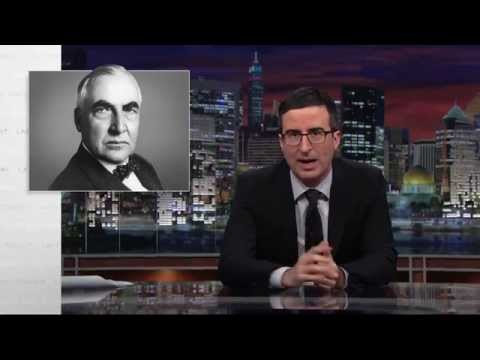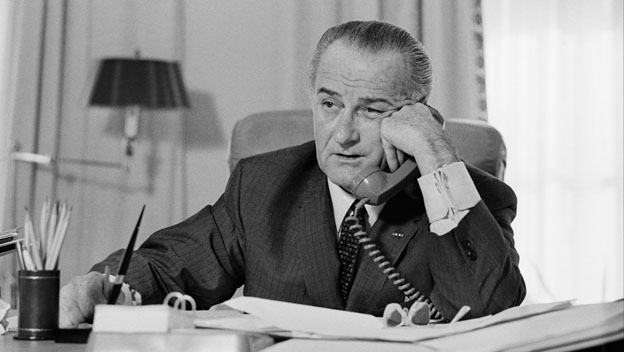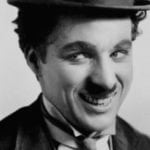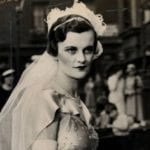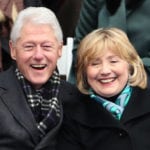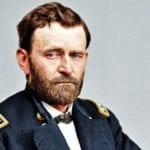10Dwight D. Eisenhower
Dwight D. Eisenhower is considered one of America’s most successful military leaders, serving as Supreme Commander of the Allied invasion of Europe during World War II. But the task of taking the fight to the Nazis meant long periods of separation from his wife, Mamie. Perhaps that’s why Ike began the affair that was soon being gossiped about all the way back in Washington. Photos of Eisenhower often showed him accompanied by his lovely secretary and driver, Kay Summersby, often standing just a little too close. After years of falling in love emotionally, Kay and Ike allegedly consummated their affair in the spring of 1944. Or at least they tried to—according to Summersby, Ike was actually impotent, confessing that marriage had “killed something” in him. As a result, she had to take the lead and teach him about sex during their trysts. When the war ended, Ike sent a formal request to his superior officer, General Marshall, to be relieved of duty so he could divorce Mamie and marry Kay. An outraged Marshall refused, promising to force Eisenhower out of the army and ruin his life should the divorce happen. As a result, the relationship ended, only coming to light in 1975. With Kay dying and Eisenhower already deceased, she decided to publish a book about the relationship.
9Warren G. Harding
Usually considered a remarkably poor president, Warren G. Harding was said to value being liked over being a strong leader. Perhaps that helps explain his notorious weakness for women. The most famous of his relationships was with Carrie Phillips, which started in 1905, despite the fact that both were married (Harding was actually good friends with Carrie’s husband). The couple’s hilariously steamy love letters were opened to the press in 2014. During the 1920 presidential election, the Republican National Committee essentially bribed Carrie and her husband to stay out of sight, sending them on a free trip to Asia with $20,000 in cash. That’s not a bad deal, but some of Harding’s other lovers didn’t do so well. Before his affair with Carrie had even ended, Harding had taken up with Nan Britton, a campaign volunteer who was 30 years his junior. Nan gave birth to a baby girl in 1919 (Harding had the Secret Service hand-deliver child-support payments) and sued the Harding estate after his death to get a trust fund for the child. She lost the case, but bounced back by writing a tell-all called The President’s Daughter, dedicated “to all unwed mothers.” The book caused a scandal by detailing her numerous wild escapades with Harding, including sex in the Oval Office closet. There were more flings: a Washington Post employee named Miss Allicott and chorus girls named Maize Haywood and Blossom Jones. Two other women claimed to have conceived children by Harding (one had a son while the other terminated her pregnancy). There was also a “violent” affair during his senate years with a staffer named Grace Cross. Harding didn’t even bother to keep his affairs much of a secret, telling a private group of reporters: “It’s a good thing I am not a woman. I would always be pregnant. I can’t say no.”
8Woodrow Wilson
Woodrow Wilson married Ellen Axon in 1885. Ellen, in addition to being a gifted professional artist, was exceptionally smart and educated, and the marriage was steady until around 1906. After that, the couple had a few trying years. Ellen’s nephew, his wife, and their two-year-old son drowned in an accident, while her brother began to struggle with severe depression. Years earlier, Ellen’s father had been committed to a mental institution, and eventually committed suicide, so the plight of her brother was very disturbing. Unable to handle not having his wife’s full attention, Wilson went to Bermuda on his own in 1907 and 1908. There, he met Mary Peck. The relationship with Mary grew from friendship into a “dalliance,” devastating Ellen and leaving Woodrow “guilt-stricken.” Ellen once said that the relationship with Peck was the only unhappiness her husband had ever given her, while Woodrow himself admitted to “a passage of folly and gross impertinence” where he had put aside “standards of honorable behavior.” When Ellen died in August 1914, Wilson was utterly devastated. But he was unsuited for single life and began seeing a widow named Edith Galt in early 1915. Wilson’s advisers did not approve, believing the public would hold the relationship against him. The spreading gossip wasn’t helped when the Washington Post accidentally noted that “the President has been entering Edith Bolling Galt regularly.” Obviously, “entering” was intended to be “entertaining,” but the damage was done. A popular joke of the era poked fun at the situation: Question: “What did Mrs. Galt do when the President of the United States proposed to her?” Answer: “She fell out of bed.” The relationship was soon in further jeopardy as the Mary Peck rumors started swirling. Edith married him anyway in late 1915. Wilson was re-elected despite the scandal.
7James Garfield
While in school, James Garfield was obsessed with sex, homosexuality, and masturbation, and frequently took cold showers to ward off temptation. Despite his attraction to independent women, he felt obliged to marry “an asexual wallflower,” Lucretia “Crete” Rudolph, whom he met while studying and working as a janitor at the Eclectic Institute in Hiram, Ohio. Crete and Garfield were engaged in 1854, but he began sleeping with a “sensuous and witty” friend named Rancie Selleck within a year. Crete was aware of the affair, which lasted until 1858, calling it the “keenest dagger to my heart.” It wouldn’t be the last of Garfield’s indiscretions. In 1862, he had a liaison with an 18-year-old reporter for the New York Tribune named Lucia Gilbert Calhoun. There was a long-term relationship with an Eclectic Institute student named Almeda Booth. When Crete confronted Garfield about Booth, he confessed everything, calling it a “lawless passion.” Garfield’s womanizing was so prolific that Crete kept herself out of the press for fear that her presence would be an invitation for public charges of infidelity. Despite this, the 1880 election was rocked by allegations that Garfield had visited a New Orleans prostitute.
6George H.W. Bush
The Washington Post once pointedly noted that political aide Jennifer Fitzgerald had “served President-elect George Bush in a variety of positions.” Although rumors of an affair were “well-known” among journalists, nothing was published until 1988, when the alternative paper LA Weekly ran a story claiming that Fitzgerald had spoken openly about the relationship. In 1992, the tabloid New York Post repeated the allegations and more sources soon emerged. In her book The Power House, the journalist Susan Trento claimed that US ambassador Louis Fields had arranged for Bush and Fitzgerald to share a guest house during an official visit to Geneva in 1988. Speaking to Trento’s husband Joe, Fields supposedly admitted that “it became very clear to me that the Vice President and Mrs. Fitzgerald were romantically involved.” The Trentos didn’t immediately report the comments at the request of the ambassador, who was worried they would damage his career, but went public after his death. The allegations were then largely forgotten until the notorious “unauthorized biographer” Kitty Kelley repeated them in The Family, her 2004 book on the Bushes. According to Kelley, longtime Republican stalwart James Baker refused to run Bush’s 1980 presidential campaign as long as Fitzgerald was in the picture. Unlike most of the entries on this list, the allegations surrounding Bush and Fitzgerald were never conclusively proven and the Bush family have gone to great lengths to refute them. When reporter Mary Tillotson asked Bush about the affair during a live news conference, his staff were reportedly incensed, vowing that Tillotson would “never work around the White House again.”
5Lyndon Johnson
As Lady Bird Johnson once put it: “My husband loved people. He loved all people. Now, half the people in the world are women. You don’t think I could have kept my husband away from half the people in the world, do you?” Lyndon and Lady Bird married in November 1934, despite being complete opposites in many ways. Johnson, explosive, ambitious, and a natural politician, would frequently bully the demure, shy, and intellectual Lady Bird. By 1937, Lyndon had begun an affair with Alice Glass, the wife of one of his major supporters. Although their relationship could have ended his political career, the affair continued until the late 1940s. While Lady Bird had no interest in clothes or makeup, Alice Glass commanded attention as soon as she entered the room. Well aware of the relationship, Lady Bird blamed herself. In response, she became more social, lost weight, and started wearing sexier clothing and makeup, but feigned ignorance when Alice or any other woman came up in connection with her husband. Meanwhile, LBJ didn’t limit himself to only one affair, once bragging that he’d “had more women by accident than Kennedy ever had on purpose.” After Lady Bird walked in on her husband having sex with one of his secretaries in the Oval Office, the Secret Service installed a buzzer system to alert the President whenever his wife was nearby. One of the few women to make her story public is Madeleine Brown, who claims that she was LBJ’s mistress for 21 years. Brown claims that Johnson set her up in a two-bedroom home with a maid and gave her credit cards and cars. Apparently, Johnson was “kinky” and their meetings would generally last around 30 minutes.
4Grover Cleveland
One of only three presidents to get hitched while in office (John Tyler and Woodrow Wilson are the other two), Grover Cleveland married Frances Folsom in 1886. There was more than a hint of scandal about the match, since Folsom was 27 years younger than her husband (he had actually bought her baby carriage). To make things even creepier, Folsom had actually been Cleveland’s ward ever since her father died when she was nine. However, this was nothing compared to what had happened in Cleveland’s past. In 1873, when Cleveland was 37 years old, he was courting a sales clerk named Maria Halpin. On December 15, he took Maria Halpin out for dinner and then insisted on accompanying her home. According to Halpin, Cleveland then raped her “by use of force and violence and without my consent.” Halpin also claimed that Cleveland threatened to “ruin” her if she told anyone what had happened. Six weeks later, she discovered that she was pregnant. When the child was born, Cleveland had Maria arrested and committed to an insane asylum, placing his newborn son into an orphanage. Thankfully, the asylum’s director recognized the abuse of power and released Maria immediately, claiming that she had been committed “without warrant or form of law.” She did not get her son back. When the scandal became public, Cleveland spread a rumor that Halpin was a drunk who had engaged in affairs with at least three married men. According to this version of events, the child really belonged to Oscar Folsom (father of Frances) and the saintly Grover only took responsibility to preserve his married friend’s reputation. But in reality, Halpin was a churchgoing widow with two young children and a good reputation. Throughout her life, she insisted that “there is not and never was a doubt as to the paternity of our child, and the attempt of Grover Cleveland or his friends to couple the name of Oscar Folsom or anyone else with that of the boy is simply infamous and false.” Furthermore, Buffalo United Presbyterian Church Pastor Henry Crabbe went on record to describe Cleveland as “a corrupt, licentious man. He has never been married and is notoriously bad with women. It may be said these stories are put into circulation for political effect, but the trouble is they cannot be refuted.”
3George Washington
In March 1758, a young George Washington decided to pay a visit to the newly widowed Martha Custis, the richest woman in Virginia. By January 1759, they were married. However, it seems as though Washington may have had second thoughts—in 1877, a newly discovered letter he wrote to his old flame Sally Fairfax appeared on the front page of the New York Herald. The letter, written while George and Martha were formally engaged, starts coyly: “I profess myself a votary of love. I acknowledge that a lady is in the case and further I confess that this lady is known to you.” Eventually, Washington makes his feelings plain: “misconstrue not my meaning; doubt it not nor expose it. The world has no business to know the object of my love declared in this manner to you when I want to conceal it. One thing above all things in this world I wish to know, and only one person of your acquaintance can solve me that.” At the time of the letter, Sally Fairfax was already married to a close friend of Washington. But Fairfax’s response was deliberately non-committal and it seems that she and Washington didn’t speak of the matter again. In 1775, the British made an attempt to discredit Washington with a forged letter revealing his affair with “Kate the washerwoman’s daughter,” but there is no convincing evidence that he was unfaithful to Martha after their marriage.
2James Buchanan
Years before James Buchanan entered the White House, he was engaged to a wealthy heiress, Anne, who died suddenly a few days after their engagement was broken off. Her family refused Buchanan entry to her funeral, blaming him for the death. Local gossip speculated that she had been devastated to discover that he was seeing other people behind her back. As sad as it was, Anne’s death might not be the only reason Buchanan was the first (and last) bachelor president. For 23 years, Buchanan lived with Senator William King, not as roommates sharing a house, but actually sleeping together in the same room. Some historians have pointed to the relationship as a good reason to call Buchanan our first gay president. One congressman referred to Buchanan and Senator (later Vice President) King as “Buchanan and his wife,” while others referred to King as “Aunt Fancy” and the pair as “Siamese twins.” Historian James Loewen points to Buchanan as being “fairly open” about the relationship, noting the few surviving letters between the two are indicative of their devotion. As Buchanan wrote to a friend regarding King’s departure for France: “I am now solitary and alone, having no companion in the house with me. I have gone a wooing to several gentlemen, but have not succeeded with any one of them.” For his part, King wrote to Buchanan: “I am selfish enough to hope you will not procure an associate who will cause you to feel no regret at our separation.” Sadly, most of the letters between the pair were destroyed by relatives and it is likely we will never be completely certain as to the nature of their relationship.
1FDR And Eleanor Roosevelt
Franklin Roosevelt’s infidelity is fairly well-known at this point, but his marriage to Eleanor Roosevelt was much more complicated than just one woman on the side. At one point, the President and First Lady might both have had mistresses living in the White House. The catalyst was Lucy Mercer, a woman who was hired to be Eleanor’s social secretary. Her affair with FDR was soon common knowledge among the Washington elite. Teddy Roosevelt’s power player daughter, Alice Longworth, even went so far as to provide a spot for Lucy and FDR’s private time. When Eleanor found the love letters between her husband and secretary, she demanded a divorce. FDR was actually pretty receptive to the idea. He wanted to marry Lucy, who was a far better match for him than Eleanor, but his domineering mother put the kibosh on any separation by threatening to withdraw her financial support if the marriage wasn’t fixed. FDR’s political mentors agreed, rightfully saying that a divorce would be political suicide. FDR gave in, choosing money and career over love, and asked Eleanor for forgiveness. She agreed to stay in the marriage on the condition that FDR never see Mercer again (didn’t happen). Eleanor also insisted that she and FDR no longer share a bed. The affair devastated Eleanor. Now known by modern observers as a powerful force in politics and one of the most respected First Ladies, she was initially painfully shy and insecure regarding her abilities. Eventually, she befriended two lesbian couples, Elizabeth Read and Esther Lape and Nancy Cook and Marion Dickerman, who became role models, showing Eleanor she could establish an identity outside of her husband. Over time, Eleanor would become a powerful force on the political scene. Her relationship with FDR became what Joseph Alsop called a “highly successful working partnership” rather than a “normal marriage.” Eventually, tongues began to wag about Eleanor’s relationship with the female reporter Lorena Hickock. While Hickock, who was “sexually oriented to women” was almost certainly in love with Eleanor, it’s hard to be sure if her feelings were reciprocated. Eleanor was certainly very fond of her, writing that when Hickock was away “I can’t kiss you, so I kiss your picture good night and good morning!” When FDR was elected President, she invited Hickock to live with her in the White House, telling her not to worry about gossip: “I am always so much more optimistic than you are. I suppose because I care so little about what ‘they’ say.” FDR certainly didn’t mind—he was having his own affair with his live-in assistant, Missy LeHand. Kindree Cushing has never slept with a President.

